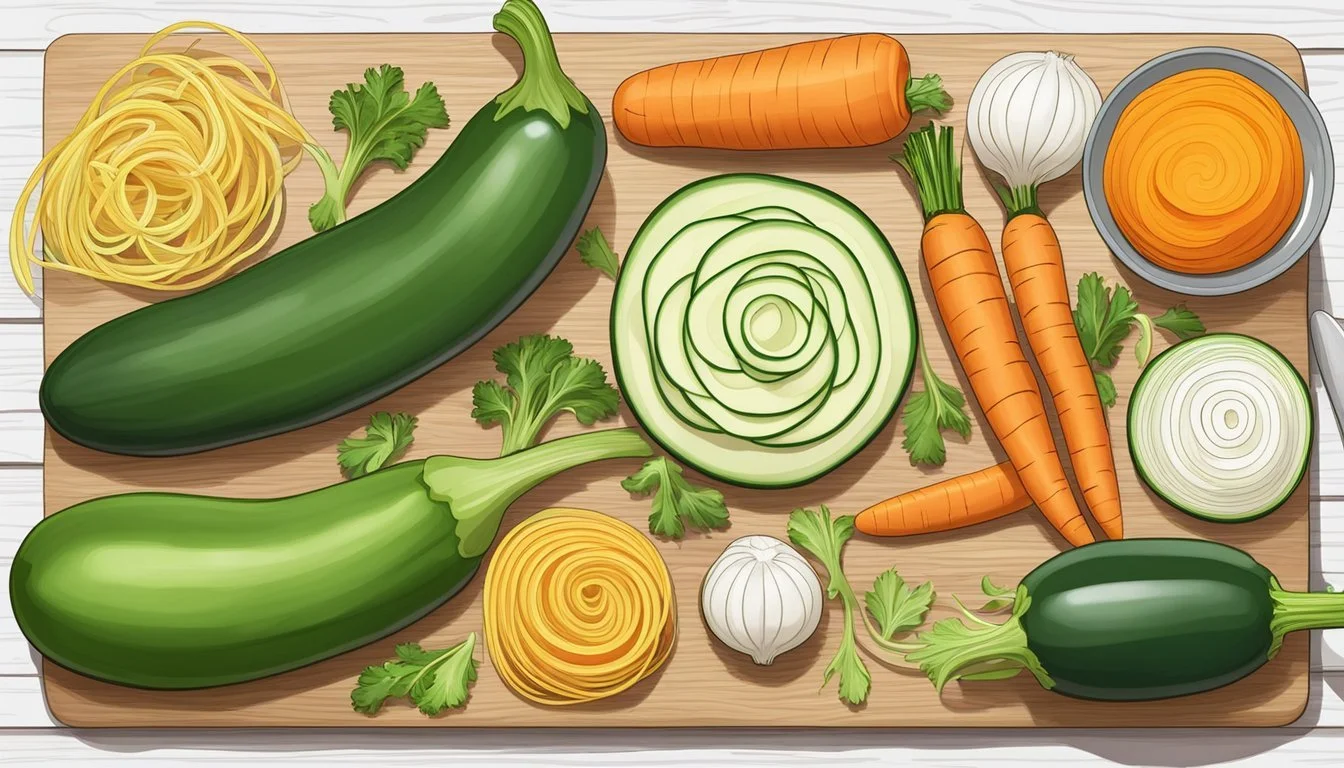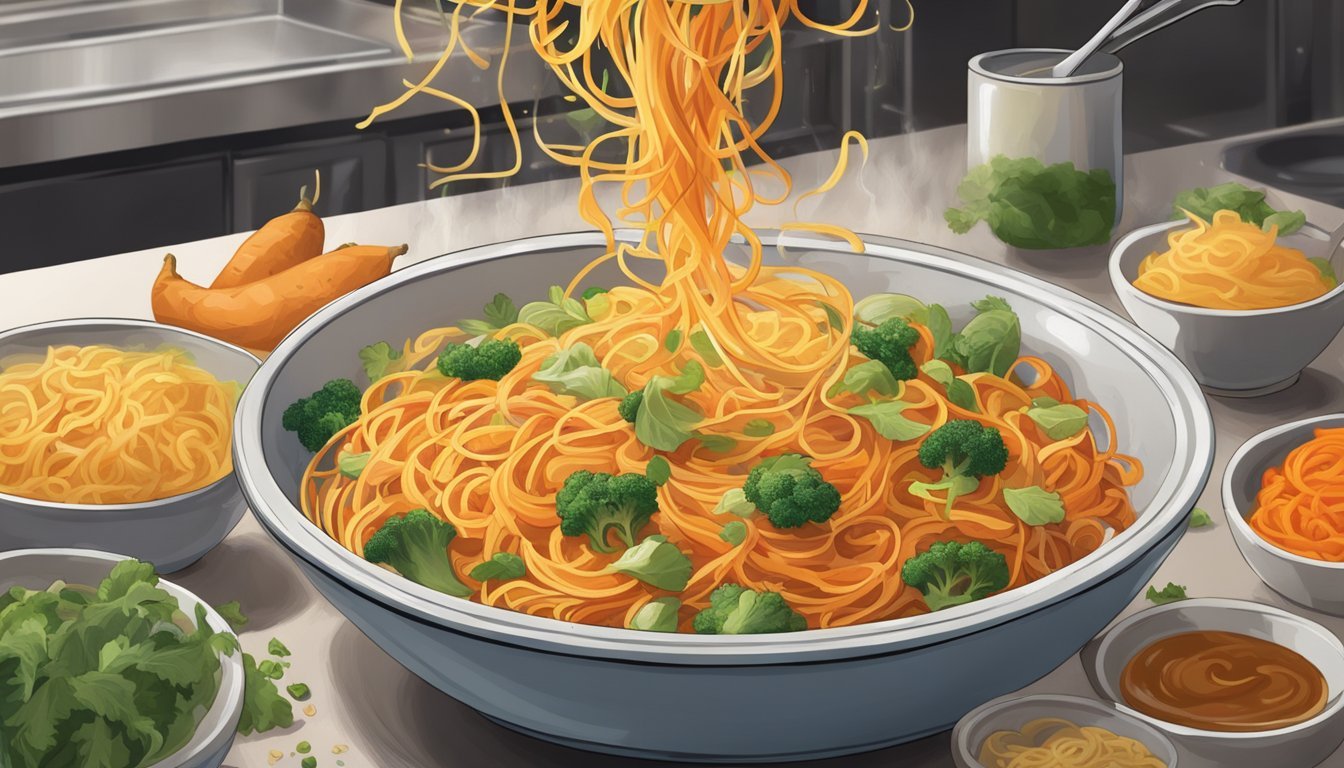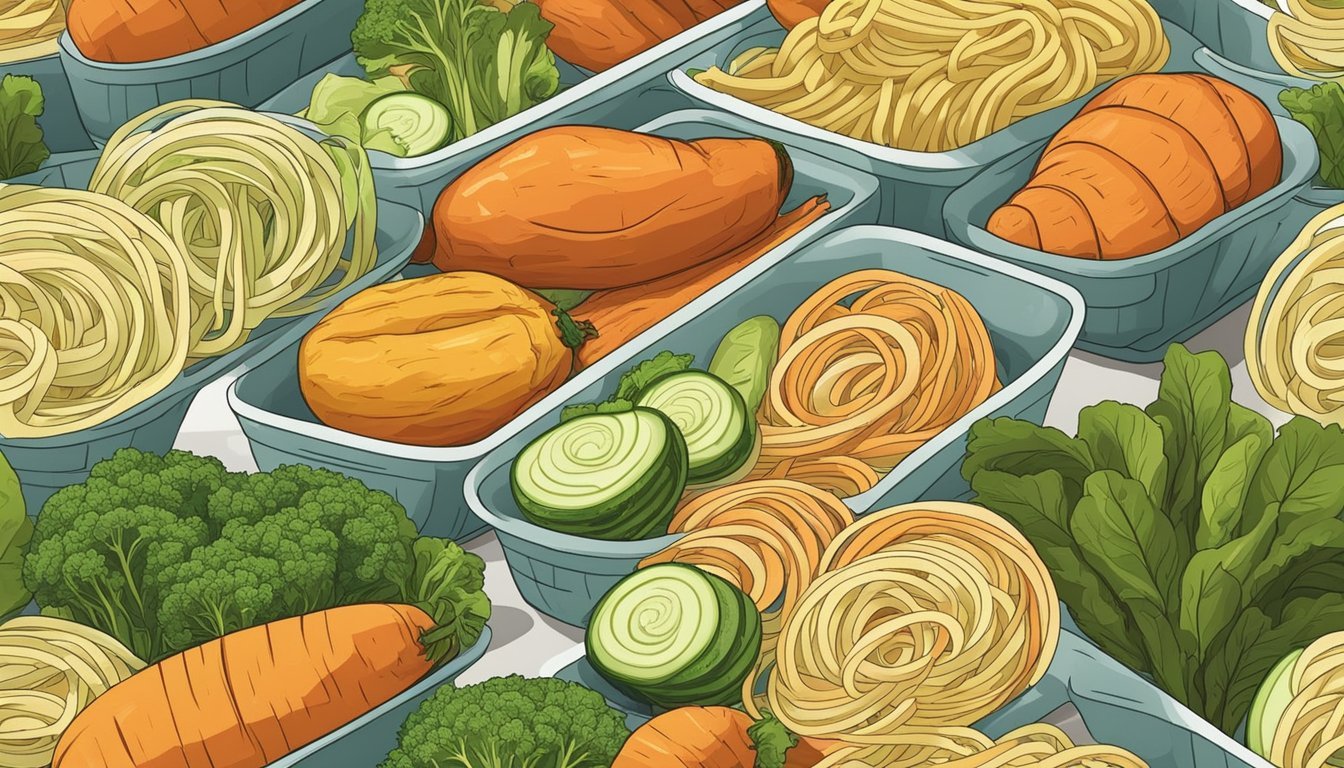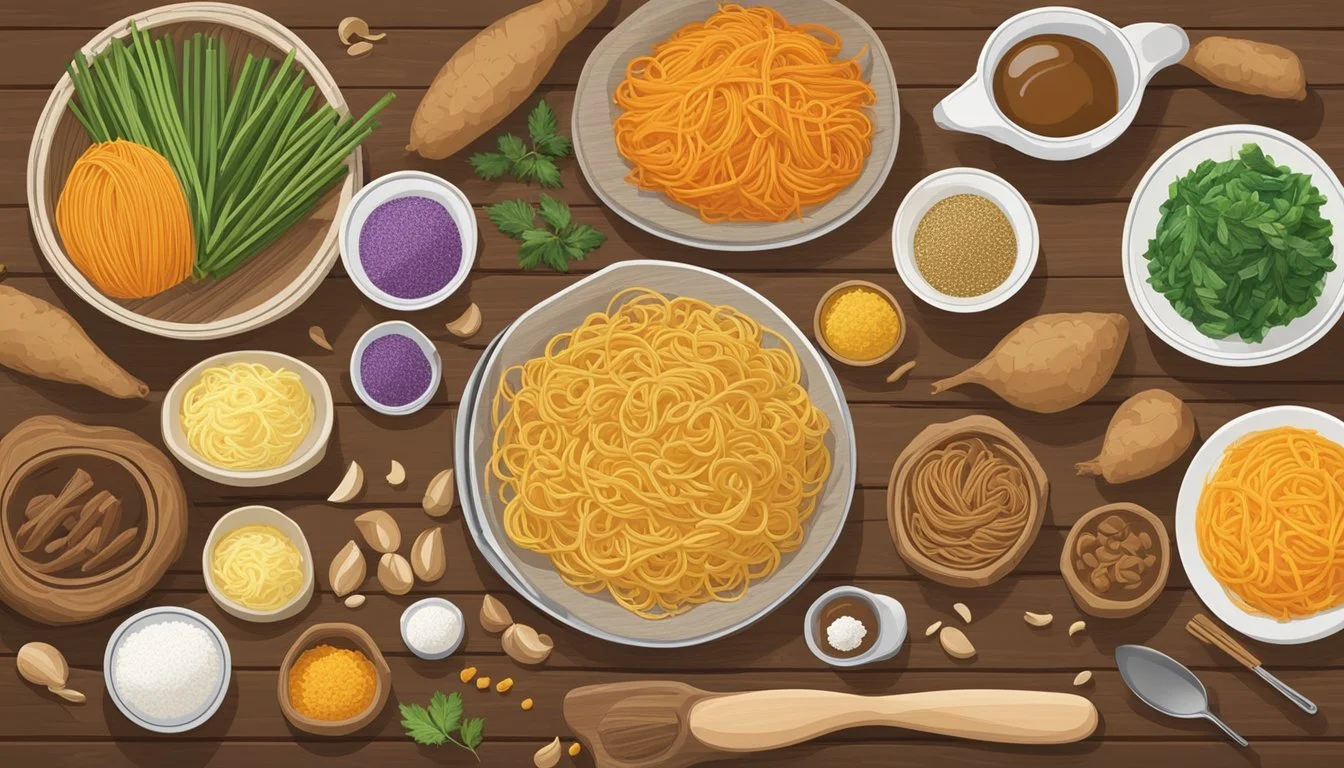Sweet Potato Noodle Substitutes
Top Alternatives for Healthy Meals
Sweet potato noodles, often used in Korean dishes like Japchae, have become a popular choice for health-conscious individuals. These noodles are gluten-free, which makes them an excellent option for those with celiac disease or gluten sensitivity. They also provide an array of nutrients such as vitamin A, which is essential for eye health, and are generally considered to be a lower-calorie and lower-carbohydrate alternative compared to traditional pasta.
Made from sweet potato starch, these noodles offer a chewy texture and slightly sweet taste that complements a variety of recipes. While they contain some fiber and protein, their nutritional density is particularly noteworthy for those monitoring their macronutrient intake. For individuals following a low-carb diet, sweet potato noodles can be a fitting choice, offering a way to enjoy noodle dishes without straying from their dietary goals.
Despite their benefits, some may look for substitutes due to dietary restrictions, availability, or personal taste preferences. Substitutes for sweet potato noodles range from vegetable spirals, such as zucchini or carrot noodles, to other gluten-free options like rice or shirataki noodles. These alternatives each come with their own nutritional profiles and culinary characteristics, allowing individuals to tailor their choice to fit their nutritional needs and flavor preferences.
Understanding Sweet Potato Noodles
Sweet potato noodles, a staple in Korean cuisine known as japchae, are gaining popularity for their unique texture and nutritional value. Composed primarily of sweet potato starch, they are a versatile ingredient often used in stir-fries and other dishes.
Nutritional Profile
Sweet potato noodles are low in calories but high in carbohydrates, making them an energy-dense food choice. They are also a gluten-free alternative to traditional wheat-based noodles. On average, a one-cup serving contains the following:
Calories: Approximately 100-200
Carbohydrates: 20-25 grams
Fiber: 0-1 grams
Protein: 0-1 grams
Vitamin A: Negligible amounts unless enriched or naturally occurring from sweet potato content
Health Benefits
Consuming sweet potato noodles can contribute to dietary fiber intake, which supports healthy digestion. Their low-fat and gluten-free nature makes them a suitable choice for individuals with certain dietary restrictions.
Culinary Uses
Sweet potato noodles are versatile in the kitchen and are primarily known for their use in japchae, a popular Korean noodle dish. They can be boiled, fried, or baked and are commonly used in:
Stir-fries
Salads
Vegan dishes
Sweet Potato Varieties
There are various types of sweet potatoes used to make noodles, with differences in texture, flavor, and color:
Ube: Purple and sweet, often used in desserts
Yams: Drier and starchier than sweet potatoes
Garnet and Jewel Potatoes: Deep orange and sweet
Japanese Sweet Potatoes: White flesh and a nutty flavor
Cooking Techniques
Sweet potato noodles are typically prepared through one of the following methods:
Boiling: Cook for 5-7 minutes until tender but still chewy.
Frying: Can be added to a stir-fry directly or pre-boiled for a softer texture.
Baking: Less common, but can be incorporated into casseroles.
Gluten-Free Alternatives
For those requiring gluten-free options, sweet potato noodles serve as an excellent substitute. They maintain a similar texture to Korean glass noodles without the gluten found in traditional pasta.
Substitutes for Sweet Potato Noodles
Sweet potato noodles are popular for their flavor and health benefits, including a rich fiber content and being gluten-free. For those looking to explore alternatives, there are a variety of substitutes that cater to different dietary needs and flavor profiles.
Vegetable Noodles
Vegetable noodles are a low-calorie, nutrient-dense option. Zucchini noodles, commonly known as "zoodles," are a well-liked substitute that provides a similar texture with fewer calories. Carrot noodles serve as another vibrant, fiber-rich alternative, offering a slightly sweeter taste and crunch.
Other Potato Noodles
Substituting with noodles made from other potatoes such as russet, Yukon gold, or white potatoes can provide a similar starchy base with varying levels of sweetness. These alternatives are readily available and can be spiralized into noodle shapes using a spiralizer.
Alternative Starch Noodles
For those seeking alternatives outside the potato family, noodles made from other starchy vegetables like butternut squash, parsnips, or pumpkin capture a hearty texture. Squash varieties, in particular, offer lower calories and a gluten-free profile.
Grain-Based Noodles
Whole wheat noodles are a substitute offering more fiber and nutrients than traditional white pasta. Rice noodles are another alternative, known for their lightness and compatibility with a gluten-free diet, making them suitable for those with specific dietary restrictions.
Legume-Based Noodles
Noodles made from legumes like black bean or edamame deliver a high-protein, fiber-rich alternative to sweet potato noodles. These options are not only gluten-free but also come with added health benefits, including a lower glycemic index.
Incorporating Noodle Substitutes into Dishes
When exploring noodle substitutes like sweet potato noodles, one must consider how to adapt them into various dishes. This section offers guidance on implementing these alternatives while maintaining the integrity and flavor profile of the original recipes.
Dish Adaptations
To seamlessly introduce noodle substitutes such as sweet potato noodles, carrot spirals, or zucchini noodles into traditional dishes like japchae or Italian pasta, one should:
Match textures: Assess the cooking time and method to ensure the substitute mimics the original noodle's tenderness.
Maintain dish structure: Use these substitutes in stir-fries or baked dishes, where they can integrate without altering the dish's composition.
Seasoning Combinations
Proper seasoning ensures that noodle substitutes blend well with the overall flavor profile of the dish:
Complementary flavors: Sweet potato noodles pair well with both bold and subtle flavors, such as garlic, onions, and sweet peppers.
Balancing spices: A pinch of salt and pepper is essential, and herbs like thyme can add an aromatic touch.
Sauce Pairings
Choosing the right sauce can enhance noodle substitutes while also providing moisture and cohesion to the dish:
Asian-inspired: Soy sauce and sesame oil work beautifully with sweet potato noodles, particularly in dishes like japchae.
Italian sauces: Marinara or Alfredo sauce can be used to dress substitutes in lieu of spaghetti or fettuccine.
Substitute Sauce Recommendation Sweet Potato Teriyaki, Soy Sauce Carrot Spirals Marinara, Pesto
Toppings and Garnishes
The right garnish can transform a simple dish into an exquisite meal:
Fresh herbs: Cilantro and green onions provide a fresh burst of flavor.
Crunch and texture: Sprinkle toasted sesame seeds or pepitas for an added crunch.
Dish Type Ideal Garnish Stir Fry Sesame Seeds, Thyme Dinner Cilantro, Pepitas
Strategic ingredient combinations and thoughtful preparation methods are key to successfully incorporating noodle substitutes into various dishes.
Health Considerations and Dietary Restrictions
When considering sweet potato noodle substitutes, individuals must be aware of compatibility with certain dietary restrictions and health goals. This includes adherence to specific diets such as low-carb and keto, addressing allergy concerns, and respecting vegan or vegetarian dietary choices.
Low-Carb and Keto Diet Options
Sweet potato noodles are often higher in carbohydrates than some individuals may want for a low-carb or keto diet. For those seeking to reduce their carb intake, options like zucchini noodles (zoodles) made with a spiralizer can offer a nutritious and satisfying alternative. Zucchini is low in carbs and calories, yet rich in essential nutrients. Shirataki noodles, made from the konjac plant, are another excellent substitute for their low-carb and gluten-free profile, however, they lack significant protein content.
Low-Carb Noodle Alternatives Carb Content Notes Zucchini Noodles Low High in vitamin A; use a spiralizer for preparation Shirataki Noodles Very Low Gluten-free and low in calories, but minimal protein
Allergy-Friendly Choices
For individuals with gluten intolerance or nut allergies, it's crucial to find sweet potato noodle substitutes that don’t jeopardize their health. Noodles made from rice or quinoa can be good gluten-free options, though they might not be suitable for a low-carb diet. With no allergenic wheat proteins, rice noodles are safe for a gluten-free diet and yield a similar texture to traditional noodles. Meanwhile, quinoa noodles provide a higher protein alternative that is both gluten-free and nut-free.
Vegan and Vegetarian Adjustments
Vegans and vegetarians looking to replace sweet potato noodles can rely on vegan japchae, a dish traditionally made with sweet potato glass noodles that are naturally vegan-friendly. Additional substitutes might include noodles made from a variety of spiralized vegetables, such as carrots or beets, providing a vibrant and nutrient-dense choice rich in vitamins without compromising vegetarian principles. These vegetable noodles deliver a host of benefits, including essential nutrients like vitamin A for those seeking a rich, vegetable-based source of this vitamin.
Cooking and Preparation Tips
When substituting sweet potato noodles in recipes, consider factors like prep time, cook time, and the desired texture of the final dish. Using a spiralizer for homemade noodles can influence these aspects significantly.
Making Noodles at Home
To make homemade sweet potato noodles, one will need a spiralizer or a peeler. Using a spiralizer produces uniform spirals and is typically quicker. If a peeler is used, it may take a bit more time and effort to achieve noodle-like strips. It is important to wash and peel the sweet potatoes, ensuring that the ends are flat for easy spiralizing.
Equipment Prep Time Spiralizer 5-10 minutes Peeler 10-15 minutes
Proper Cooking Times
Cooking times can affect the final dish's texture, so it is crucial to monitor this closely. For boiling, cook sweet potato noodles for 5-7 minutes until they are tender yet slightly firm, often referred to as al dente. If one prefers a softer, creamier texture, boiling for a minute or two longer is recommended.
Method Cook Time Texture Boiling 5-7 minutes Al Dente Boiling 7-9 minutes Creamy
Texture and Consistency
To stop the cooking process and preserve a desired texture such as al dente, crunchy, or creamy, rinse cooked noodles in cold water. The noodle’s texture is pivotal to how it holds up against sauces and dressings. Sweet potato noodles can offer a unique bite – more substantial than traditional pasta if undercooked, or comfortably soft if allowed to cook longer.
When sautéing, use medium-high heat to create a slightly crunchy texture on the outside while keeping the inside tender. Cook the noodles for approximately 3-5 minutes, stirring to promote even cooking and prevent clumping.
Method Time Resulting Texture Sautéing 3-5 minutes Outside Crunchy, Inside Tender
Exploring World Noodles
The world of noodles offers a rich tapestry that blends tradition with modern innovation. Each region presents unique ingredients and methods, creating a variety of noodle dishes to explore.
Asian Noodle Varieties
Asian cuisine is known for its wide assortment of noodles, where each type brings its own texture and flavor to the table. Among these, Korean glass noodles, also known as sweet potato noodles, are a staple in dishes like japchae. This classic Korean noodle dish marries the chewy texture of the noodles with a mix of stir-fried vegetables and a savory sauce. Another popular option includes buckwheat noodles, which are often served cold with a dipping sauce in Japanese cooking.
Italian Pasta Alternatives
Italian cuisine's usage of pasta extends to shapes such as fettuccine, spaghetti, and penne, each paired with sauce and ingredients to complement its form. For instance, the ribbons of fettuccine are typically served with thicker sauces. Gnocchi, although not a noodle, is a noteworthy Italian dumpling that serves as a comforting alternative, often potato-based and known for a soft, pillowy texture.
Noodles in Fusion Cuisine
In fusion dishes, chefs incorporate noodles into innovative cooking practices, blending elements from various cuisines to create something unique. One could encounter sweet potato noodles in a dish combining Korean flavors with Italian pesto, resulting in a vibrant and new culinary experience. The adaptability of noodles makes them perfect for fusion cuisine, as they can be dressed up with endless combinations of flavors and ingredients from different cultures.
Nutritional Comparison of Noodle Substitutes
When considering noodle substitutes, it's essential to assess their nutritional profiles, including calorie count, macronutrient distribution, and micronutrient density, to make informed dietary choices.
Caloric Differences
Sweet potato noodles offer a lower calorie alternative to traditional pasta. For example, 100 grams of sweet potato noodles contain significantly fewer calories than the same amount of regular pasta.
Sweet Potato Noodles: Approximately 84 calories
Regular Pasta: Approximately 131 calories
Macronutrient Content
The macronutrient balance—carbohydrates, proteins, and fats—is a crucial factor in any nutritional comparison.
Carbohydrates:
Sweet Potato Noodles: Roughly 20 grams
Regular Pasta: About 25 grams
Protein:
Sweet Potato Noodles: Generally 1.5 grams
Regular Pasta: Close to 5 grams
Fiber:
Sweet Potato Noodles also tend to have higher fiber content than traditional pasta, aiding in satiety and digestion.
The macronutrient profile illustrates that sweet potato noodles are lower in carbohydrates and protein but are an excellent choice for those looking to reduce calorie intake without sacrificing volume.
Micronutrient Density
Sweet potato noodles stand out for their micronutrient content, offering a valuable source of vitamins and minerals.
Vitamin A:
Sweet Potato Noodles: High in Vitamin A, crucial for vision and immune health
Minerals:
These noodles have a more favorable mineral profile, including potassium, manganese, and copper, compared to regular pasta.
This density of micronutrients in sweet potato noodles can contribute significantly to meeting daily nutritional requirements, particularly for Vitamin A and essential minerals.
Recipes and Serving Ideas
In this section, various sweet potato noodle recipes are explored, extending from savory stir-fries to sweet desserts. Each recipe suggests alternative ingredients to add a unique twist, incorporating elements such as honey, nuts, and green onions to enhance the overall flavor profile.
Creative Sweet Potato Noodle Recipes
Sweet potato noodles, known for their firm texture, fit seamlessly into a range of dishes. A popular Korean dish, japchae, traditionally made with sweet potato glass noodles, can be reinvented by using sweet potato noodles stir-fried with sesame oil, soy sauce, garlic, and a mix of vibrant vegetables like baby spinach and kale. For a nuttier essence, one may sprinkle toasted sesame seeds or slivered almonds on top before serving.
Enhancing Flavor with Substitutes
When aiming to bolster the flavorful qualities of sweet potato noodles, chefs often incorporate various sauces and garnishes. A vegan japchae can integrate a sweet and savory sauce blend made from soy sauce, a bit of brown sugar, and orange juice. For an additional layer of flavor, fresh green onions can be added alongside baby spinach, punctuating the dish with a mild, oniony crispness.
Dessert and Sweet Applications
Transitioning sweet potato noodles from a savory base to a sweet treat allows for culinary creativity. A dessert variation might involve tossing the noodles with a mixture of honey, maple syrup, and a dash of cinnamon, then baking until they caramelize slightly. Serving them with a dollop of whipped cream and a sprinkle of toasted nuts takes advantage of their natural sweetness, offering a unique dessert option or a sweet side dish.
Resources and Further Reading
Exploring sweet potato noodle substitutes not only diversifies one's palate in the realm of cuisine, but also encourages a nutritionally conscious approach to cooking. For those seeking to expand their culinary expertise or simply aiming to understand the calorie content and nutritional density of food, various resources are available.
Cookbooks and Food Blogs
Cookbooks and food blogs offer a treasure trove of recipes that provide both inspiration and instruction. For sweet potato noodles and their substitutes, readers may find "Asian Noodles: Science, Technology, and Processing" helpful in understanding different noodle varieties and methods of preparation. Additionally, food blogs such as NouveauRaw and Minimalist Baker offer unique recipes that often include sweet potato noodles, addressing both taste and nutrition factors.
Recommended Reading:
"The Sweet Potato Lover's Cookbook: More than 100 ways to enjoy one of the world's healthiest foods" – contains recipes that highlight sweet potato's versatility.
Nouveauraw.com – features raw, vegan, and gluten-free recipes for a healthier take on traditional dishes.
Nutritional Guides
Nutritional guides provide detailed information about the calorie count and nutritional content of foods, including sweet potato noodles. They also highlight the benefits of vitamin A and other nutrients found in sweet potato. Such guides can be found in health publications or culinary magazines that emphasize nutritional education.
Resources to Consider:
USDA National Nutrient Database – offers comprehensive nutrient profiles for foods, including sweet potatoes.
NutritionData.Self.com – gives a complete breakdown of the nutritional content and health benefits.
Cooking Workshops and Classes
Sweet potato noodles can be a novel ingredient for many home cooks. Cooking workshops and classes are excellent avenues for skill development, as they provide hands-on experience and professional guidance. These classes might introduce various preparation and substitution methods, emphasizing cooking as both an art and a nutritional science.
Where to Look:
Local culinary schools or community centers – often offer workshops focused on specific cuisines or cooking techniques.
Online cooking platforms like MasterClass or Skillshare – host classes by renowned chefs that explore a wide range of dishes, including those featuring sweet potato noodles as a core ingredient.







